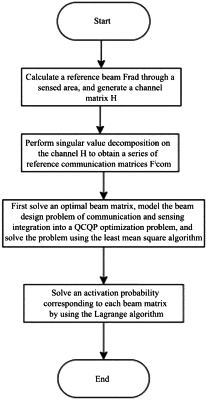| CPC H04B 7/06952 (2023.05) [H04B 7/0408 (2013.01); H04B 7/0413 (2013.01)] | 2 Claims |

|
1. A non-uniform beam spatial modulation method applicable to multi-antenna communication and sensing integration, comprising:
finding an Integrated Sensing and Communication (ISAC) beam that satisfies both sensing performance and communication performance; and
finding a spectral efficiency of non-uniform beam spatial modulation by using the ISAC beam, and completing the non-uniform beam spatial modulation, wherein
the finding the ISAC beam that satisfies both sensing performance and communication performance comprises:
constructing a communication transmitting signal; constructing a communication receiving signal; constructing an upper bound of an integrated communication and a sensing spectral efficiency of the non-uniform beam spatial modulation; constructing an objective function of the sensing performance; and finding a candidate beam matrix and a beam activation probability distribution where a spectrum frequency is maximum and the sensing performance is best;
the non-uniform beam spatial modulation method is applicable to a multiple-input multiple-output communication system, the multiple-input multiple-output communication system includes Nt transmitting-side antennas and Nr receiving-side antennas, and a number of data streams to be transmitted is Ns;
at a transmitting side, an information bit sequence b to be sent is divided into two parts: b1 and b2;
b1 is a spatial modulation portion, which is mapped to a beam matrix Fi ∈
 with a dimension of Nt×Ns; the beam matrix Fi satisfies probability distribution p (F=Fi)=pi; i represents a number of an i-th beam matrix F; p represents a probability distribution; F=Fi indicates that Fi is activated; pi is a probability that each beam matrix is activated; with a dimension of Nt×Ns; the beam matrix Fi satisfies probability distribution p (F=Fi)=pi; i represents a number of an i-th beam matrix F; p represents a probability distribution; F=Fi indicates that Fi is activated; pi is a probability that each beam matrix is activated;b2 is a data modulation portion, which is mapped to a symbol vector s with a dimension of Ns×1; and s satisfies a constraint condition expectation mean
 the constructing the communication transmitting signal, once the beam matrix Fi is selected, a vector of the communication transmitting signal is expressed as formula (I):
x=Fis, (I)
in formula (I), a normalized transmitting power satisfies ∥Fi∥F2=Ns;
the constructing the communication receiving signal, the communication receiving signal received by a communication receiver through a wireless channel is expressed as formula (II):
y=√ρHFis+n, (II)
in formula (II), ρ represents an average receiving power; H ∈
 Nr×Ni represents a channel matrix; and n represents a noise vector; Nr×Ni represents a channel matrix; and n represents a noise vector;the upper bound of the integrated communication and sensing spectral efficiency of non-uniform beam spatial modulation is constructed as a target of the communication performance, wherein
 = {F1, F2, . . . , FK} represents a set of candidate beam matrices, and a size of the set is K; p=[p1, p2, . . . , pK] represents a distribution of activation probabilities of various candidate beam matrices; and the upper bound of the integrated communication and sensing spectral efficiency of the non-uniform beam spatial modulation is expressed as formula (IV): = {F1, F2, . . . , FK} represents a set of candidate beam matrices, and a size of the set is K; p=[p1, p2, . . . , pK] represents a distribution of activation probabilities of various candidate beam matrices; and the upper bound of the integrated communication and sensing spectral efficiency of the non-uniform beam spatial modulation is expressed as formula (IV): in formula (IV), det represents a matrix determinant,
 and INr represents a unit matrix with a dimension of Nr×Nr;
constructing a target function of the sensing performance:
the sensing performance is measured by a desired similarity level, and the objective function of the sensing performance, a similarity level, is defined as formula (V):
 in formula (V), Frad refers to a reference beam matrix with good beam pattern characteristics, which is calculated according to a target area;
the finding the candidate beam matrix
 and the beam activation probability distribution p where the spectrum frequency is maximum and the sensing performance is best: and the beam activation probability distribution p where the spectrum frequency is maximum and the sensing performance is best:1) For optimization of
 , Fi is constructed by solving formula (VI): , Fi is constructed by solving formula (VI): in formula (VI), ηrepresents a compromise factor between communication and sensing, and Fcomi represents an ideal beam required for an ith communication;
formula (VI) is simplified to obtain formula (VII):
 in formula (VII), there are two auxiliary matrices A=[√ηINt]T and Bi=[√η(Fcomi)T, √1−ηFradT]T;
the least mean square algorithm with relatively low complexity is used to solve formula (VII), as shown in formula (VIII):
Fi=A†Bi. (VIII)
the solved Fi is multiplied with one normalization factor
 thus satisfying a power constraint requirement, that is, the candidate beam matrix
 to be found; to be found;2) For a sub-problem of an optimization of p, it is constructed as a Lagrange function, as shown in formula (IX):
 formula (IX) is solved to obtain the beam activation probability distribution p;
the finding the spectral efficiency of non-uniform beam spatial modulation using the ISAC beam, wherein the found candidate beam matrix
 and beam activation probability distribution p where the spectrum frequency is maximum and the sensing performance is best are substituted into formula (IV) to find the integrated communication and sensing spectral efficiency of the non-uniform beam spatial modulation. and beam activation probability distribution p where the spectrum frequency is maximum and the sensing performance is best are substituted into formula (IV) to find the integrated communication and sensing spectral efficiency of the non-uniform beam spatial modulation. |